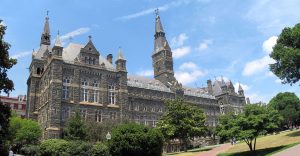While Georgetown has, at times, been considered a leader among college campuses in environmental sustainability, its level of commitment to certain sustainable causes over the years has varied. For the last three decades, student activism has continuously pushed the university to take increasingly ambitious steps towards enacting green policies and combating climate change.
As a general definition, sustainability refers to policies that intersect environmental, economic, and social responsibility.
Renewable Energy at Georgetown
Together, Georgetown’s D.C.-based campuses consume an average of 150 million kWh (kilowatt-hours) of electricity per year, a figure only slightly lower than the entirety of the Central African Republic, a country of over 4.6 million people. This immense use of power, plus the hundreds of millions of gallons of water and cubic feet of natural gas expended each year, has put pressure on the administration to offset its energy usage and environmental impact.
Georgetown’s first notable efforts towards sustainability came in 1984, when the university received a federal Department of Energy grant to install over 4,600 solar panels on the roof of the Intercultural Center (ICC) building. Despite initial delays, the panels were able to produce 360,000 kWh in their first year and operated as a source of renewable energy with diminishing effectiveness until they were decommissioned in 2011—approaching a decade beyond their initial 20-year life expectancy.
It was not until 2008—24 years after the original solar panels were installed—that the Georgetown administration would make another commitment towards renewable energy. In that year, President John DeGioia committed to reducing Georgetown’s carbon footprint by 50 percent by the year 2020, based on energy consumption levels in 2006. The university ended up reaching and exceeding its target far sooner.
By 2013, Georgetown had reduced its emissions by almost 20 percent from 2006 levels and lowered its environmental footprint by an additional 50 percent by buying RECs (Renewable Energy Credits). Purchased by Georgetown in increasing amounts since 2009, a REC transfers the rights to the environmental benefits of a certain quantity of clean energy to the buyer, allowing them to decrease their carbon footprint without decreasing their energy use. Recognizing the university’s large purchase of renewable energy, totaling 109 percent of its electrical load, the Environmental Protection Agency announced Georgetown as a Green Power Partner of the Year in 2013.
Since 2009, the cost of a REC containing 1,000 kWh of power has fluctuated between 30 cents and over a dollar, valuing the 113 million kWh purchased in 2013 as somewhere in the tens to hundreds of thousands of dollars. With these purchased RECs, the university reduced its net emissions from 109,000 metric tons of carbon dioxide in 2006 to 33,000 metric tons in 2013—comparable to the energy impact of over 4,000 households.
Solar Panels, On-campus and Afar
The next on-campus move towards renewable energy came not from the administration, but from the student-inspired initiative “Solar Street” in 2013. Originally submitting their proposal for funds from a Student Activities Fee Endowment in 2011, the student club Georgetown Energy won $250,000 to install solar panels on university-owned townhouses near campus. In 2012, over 85 percent of students voted in favor of confirming allocating the funds to Georgetown Energy.
As of 2020, six townhouses across from the main campus on 37th Street have solar panels producing 20,000 kWh a year, amounting to 27 percent of the energy required to run the townhouses they operate on. To date, these were the last solar panels installed by Georgetown, either on- or off-campus.
Despite promises in 2017 that the original ICC panels would be replaced and new panels would be added to five other on-campus buildings, the administration instead changed course and announced that they would power half of the campus’ energy needs from an offsite facility in La Plata, Maryland, 35 miles south of D.C.
The proposed location of the solar panels quickly resulted in controversy from La Plata locals due to environmental concerns posed by the university plan, including the irony of clearing 200 acres of forest in order to build the solar panels. Additionally, the site, which was deemed to be of high ecological value, hosts important bird populations and is of significance to the area’s native Piscataway Conoy Tribe.
Although the project seemed to be successfully working its way through required hearings during 2018, it began to receive heightened opposition from both local environmentalists and some members of the Georgetown community. After public hearings in early 2019, in August the Maryland Department of the Environment denied the application for a permit for the university’s business partner Origis to begin construction.
Since the failure of the La Plata installation, Georgetown has continued to more than match its energy usage through the purchase of RECs. In 2019, the university sourced nearly 160 million kWh through RECs, accounting for 130 percent of the energy used by the D.C. campuses during that year—the highest percentage and 5th highest amount of green energy among EPA partner universities.
Georgetown has also been commended for its green infrastructure, with recently constructed buildings utilizing energy more efficiently than their older counterparts. Since 2009, the university has committed to achieving a Silver certification for all new buildings on campus from Leadership in Energy and Environmental Design (LEED), a widely-used system of rating a building’s green design. As of September 2020, three buildings across Georgetown’s D.C. campuses have achieved LEED Silver certification and another five have achieved the higher Gold certification.
Student Advocacy and Organizations
Georgetown students have a lengthy history of pressing the administration to act on environmental issues, shown by the continuous presence of an active student environmental advocacy group since at least the 1980s. Although the success of this advocacy has varied, student pressure has historically preempted every major move by the administration towards environmental sustainability.
In 1991, a modern phase of student environmentalism emerged with the creation of Eco-Action, a club partially derived from the former Georgetown University Environmental Society. Through the ’90s and early 2000s, Eco-Action focused on organizing events such as Earth Week and Reyclemania, with the latter as part of a wider effort to increase rates of recycling on campus and inform students about sustainability.
Eco-Action was not the only group involved in environmental activism—in 2011, the project-based organization Georgetown Energy officially proposed what two years later would become Solar Street. While sometimes obstacles to sustainability themselves, GUSA and the Corp Green Team have also led initiatives to distribute personal recycling bins and encourage reusable cups. Notably, students formed the advocacy group Georgetown University Fossil Free (GUFF) in 2012 specifically designed to pressure the administration to divest its endowment from fossil fuel companies.
However, many of these student initiatives were hampered by the lack of an on-campus office specifically dedicated to planning and implementing environmental projects. Since 2010, there had been a campus sustainability coordinator, but the position was subordinate to the Office of the Vice President, where sustainability projects could get lost among the office’s other responsibilities. Between 2011 and 2012, students demonstrated campus-wide interest in a separate office to communicate and work with students more efficiently.
A year later, in 2013, the Office of Sustainability became a reality. The new Director of Sustainability was Audrey Stewart, an expert in green infrastructure and Georgetown’s Sustainability Coordinator since 2010. The office employs student interns each year to help develop and implement sustainability projects, and in 2018, it hired a second staff member under Stewart. As of 2020, Stewart still holds her role as director of the Office of Sustainability.
The new office did not mean the end of student involvement, however, and in 2014, multiple student groups formed Georgetown Environmental Leaders, a campus-wide informative group that runs projects within the GUSA Sustainability department. In 2016 Eco-Action and Georgetown Energy united to create the Georgetown Renewable Energy and Environmental Network (GREEN), which in 2020 continues to be the premier environmental club on campus.
Recently, students have also advocated for increased academic opportunities to study sustainability in the form of an Environmental Studies major, which became available as a minor in 2019. In a June 2020 meeting, GUSA passed a recommendation to the university to create the major, aimed at teaching students how to holistically look at environmental and climate issues. According to GUSA officials in September 2020, the university has committed to adding the major and will begin working to implement it.
GUFF and Fossil Fuel Divestment
Until 2012, Georgetown had largely avoided discussion of its most prominent financial contribution to climate change: tens of millions of dollars directly invested in the fossil fuel industry through the university endowment’s stocks. In December of that year, however, the student group GU Fossil Free (GUFF) began its eight-year struggle to divest Georgetown money from any fossil fuel company.
As a strategy, divestment refers to withdrawing all current and ceasing any future investments in companies deemed socially unacceptable. The decision can also have financial benefits—over a five-year period, investments in renewable energy companies in the U.S. produced twice the returns over fossil fuel companies. As of 2020, over 140 universities worldwide have divested from fossil fuels in some form, their collective endowments valued in the hundreds of billions of dollars.
Although smaller than those of similar universities, Georgetown’s endowment has slowly increased from $1.3 billion in 2013 to $1.9 billion in the beginning of 2020. While in 2020 the university claimed that less than five percent of this money was invested in or related to fossil fuel companies, this constitutes up to $95 million of investment, much of it financed by alumni.
After their 2012 debut, GUFF began a two-pronged strategy of engaging with the administration through formal divestment proposals while also increasing pressure on the university to act through student and outside support. These two strategies were both seen at play in 2013, when the group released an initial divestment proposal in May and secured GUSA’s endorsement of the proposal that November. In addition, a long-running petition in support of the proposal quickly garnered support among students, ultimately gathering over 3,000 signatures between 2012 and 2019.
While the divestment proposal was not finalized until 2014, it included withdrawing investments from the 200 largest fossil fuel companies over a three-year period, citing moral imperatives influenced by the university’s Jesuit identity. Bolstered by student support, in October of that year, GUFF officially submitted their proposal to the Committee on Investment and Social Responsibility (CISR), the group responsible for recommending investment changes to the Board of Directors.
However, the following January, the CISR responded to GUFF’s proposal by only recommending divestment from coal companies, which in its eyes produced the greatest environmental harm. GUFF quickly expressed disappointment at the decision, seeing it as legitimizing the investments in other fossil fuel companies and the three years promised until a review as an excuse for inaction. While GUFF would present their full proposal to part of the Board of Directors soon after, only the limited coal divestment would be officially approved that summer.
The CISR decision was a significant blow to the larger goal of full fossil fuel divestment, delaying a process that had already lasted two years since GUFF’s founding. Some of this frustration was borne out only a few months later, when three students within GUFF publicly disrupted an on-campus speaking event with World Bank President Dr. Jim Yong Kim to protest the university’s slow progress.
Later in 2015, GUFF suffered another blow when GUSA voted against holding a student referendum on divestment, despite supporting the full proposal only two years earlier. This move was especially controversial, considering GUFF gathered over 2,500 student signatures that November alone in support of the referendum. In their response, GUFF painted GUSA’s logic as flawed, citing their claims that the referendum would distract from other campus issues and that students’ opinions were irrelevant because their tuition did not contribute towards the endowment.
Ultimately, it would not be until late 2017 that divestment was considered again by the administration, when GUFF specifically advocated for divestment from companies involved in tar sands extraction, an environmentally ruinous and emission-heavy process especially prevalent in Alberta, Canada. This targeted proposal singled out 18 companies involved in tar sands production and successfully moved its way through the CISR and Board of Directors to be officially approved in 2018.
Capitalizing on this success, in early 2019 a cohort of GUFF students not on campus for the 2015 decision submitted another divestment proposal to the CISR, expanding the divestment call to include all fossil fuel companies rather than just the top 200. Despite GUFF following up their proposal in March with a memo with more details about the suggested divestment process that pushed for full divestment by 2024, the administration largely sidelined the group and did not publicly comment on the proposal.
In 2020, facing persistent silence from the administration, GUFF again resorted to student-driven pressure. In a January GUSA meeting, the Senate passed a similar resolution to what failed in 2015, introducing a student referendum on university divestment from fossil fuels to be held on Feb. 6 of 2020.
Soon after the student referendum was introduced, GUFF received their first substantive update from the university in a year, informing the group that the Board of Directors would also be voting on divestment on Feb. 6 and that officials expected it to pass. This prediction was correct, and on the afternoon of 6th, while voting was still taking place on the student referendum, Georgetown announced the full divestment of the institution’s funds from fossil fuel, to be completed in the next ten years.
Despite the timing of the announcement reducing the impact of the referendum, over 90 percent of the more than 2,300 votes were cast in favor of divestment. Additionally, the scope of the university’s policy was virtually identical to the proposal submitted by GUFF in 2019 and therefore marked a significant victory for the group, over seven years after its founding.
Development of On-Campus Recycling
Each year, Georgetown’s campus sends thousands of tons of waste to be recycled, incinerated, or laid in landfills. How the university divides where it sends its waste has not only fluctuated immensely over time, but has also been an issue of long-term frustration for students seeking to reduce waste.
From the years before Eco-Action until 2013, the university’s waste disposal program was the largest target of student-driven environmental activism. As early as 1988, the Georgetown University Environmental Society organized a miniature recycling program, and in that same year the D.C. government passed a slate of mandates that forced the university to take a more active role in reporting recycling plans and statistics.
Despite the District’s lackluster implementation of its own recycling operation, Georgetown quickly found success with the new program, winning multiple District recycling awards and, by 1996, diverting 43 percent of campus waste from landfills towards either recycling or incineration. At the time, Georgetown was the only university in D.C. to source-separate, meaning to divide its recycling by material, rather than using a single-stream process that combines all recyclable materials.
While a source-separation operation was much more sustainable than a single-stream process, it also required more student involvement to be successful, as incorrectly sorting recyclables could make entire waste bags unrecyclable. Because of this, the university had to provide every type of waste disposal at locations across campus to dissuade students from missorting trash and recyclables out of convenience.
Student groups continued to be part of the campus-wide focus on recycling, and in 2000, Eco-Action successfully pressured then-Senior Vice President DeGioia to switch Georgetown’s offices to using 30 percent recycled paper, the federal government standard at the time.
However, this streak of achievements was short-lived. By 2003, students both in and out of Eco-Action noted that Georgetown’s commitment to recycling had slacked, with the reported recycling rate at 20 percent, although in reality it may have been as low as 12 percent. Part of the problem was administrative, with responsibility over recycling divided between a recycling manager and the Office of Auxiliary Services.
Georgetown’s recycling rate did increase, however—a feat accomplished largely due to annual nationwide Recyclemania competitions supported by Eco-Action. By 2012, the rate had more than quadrupled from the 2003 estimate of 12 percent to a new rate of 52.5 percent, placing Georgetown’s recycling program in the top quarter of universities and with most of its improvement occurring in less than five years.
The transition also succeeded in limiting the amount of waste heading to landfills, with less than a quarter of the non-recycled waste being sent to one—around 15 percent of the total waste in 2012. Additionally, a new symbol of recycling on campus came in the form of 20 state-of-the-art solar compactor trash cans installed in 2009, able to drastically reduce the number of needed collection trips by physically compressing waste at no additional energy cost.
Despite these successes, the beginning of 2012 was a high watermark for recycling on campus. Later that year, the university took several steps backwards: first by indefinitely terminating the position of Recycling Manager and then by switching back to a single-stream system. The latter change especially caused confusion among students, with occasional rumors that the university no longer recycled at all circulating around the community.
As of 2020, the university still uses a single-stream system for recycling and has supported only minor initiatives to clarify the change for students, even eight years after the switch. Recent efforts have aimed to limit dining waste in the upper floor of Leo’s, including a student initiative to install bins for compostable waste in 2018 and a change back to reusable plates and cutlery in 2020 after single-use dining products were implemented in 2017.






[…] Credit: Source link […]